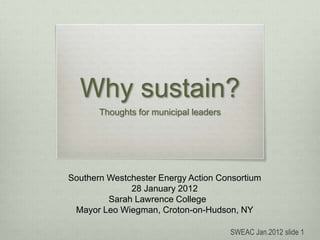SWEAC_20120128_WhySustain
- 1. Why sustain? Thoughts for municipal leaders Southern Westchester Energy Action Consortium 28 January 2012 Sarah Lawrence College Mayor Leo Wiegman, Croton-on-Hudson, NY SWEAC Jan.2012 slide 1
- 2. Reasons to believe a) $ savings? b) Climate adaptation? c) Better health? d) Safer transportation? e) Better foodways? f) National security? g) All of the above SWEAC Jan.2012 slide 2
- 3. Climate Disruption Will Cost All New Yorkers SWEAC Jan.2012 slide 3
- 4. OMG! What next? SWEAC Jan.2012 slide 4
- 5. Why measure? ŌĆ£When I die, let earth and fire mix: It matters not to me, for my affairs will be unaffected.ŌĆØ ŌĆö ancient Greek proverb ŌĆ£If you cannot measure it, you cannot improve it.ŌĆØ ŌĆö Lord Kelvin SWEAC Jan.2012 slide 5
- 6. CrotonŌĆÖs numbers SWEAC Jan.2012 slide 6
- 7. Streetlights, for example ’üČ Peekskill $591,610* ’üČ Cortlandt $144,495* ’üČ Croton $109,000 ’üČ 24% increase over 4 years ’üČ Count fixtures. ’üČ Rebid offpeak demand. ’üČ Delamp unneeded lights. ’üČ Relamp outdated fixtures *http://renewnweac.org/index-1.html SWEAC Jan.2012 slide 7
- 8. Life cycle costs matter SWEAC Jan.2012 slide 8
- 9. Build once, well. ’üČ 92% of cost of a building is the personnel inside. ’üČ Healthy buildings = a great return on salaries. SWEAC Jan.2012 slide 9
- 10. Start now! Anywhere! SWEAC Jan.2012 slide 10
- 11. Journey to the blue yonder SWEAC Jan.2012 slide 11
- 12. Questions? Thank you. Leo Wiegman lwiegman@crotononhudson- ny.gov SWEAC Jan.2012 slide 12
Editor's Notes
- #4: Did you pay more for maple syrup this year? Already in New York since 1970:Spring comes, on average, a week or so earlier. Winter snow cover is decreasing. Rising sea levels are increasing the risk of flooding. Summers have more super-hot days. Diseases typical of warmer climates are appearing. Warmer average temperatures cause more intense precipitation. Food production capacity is changing due to warming trend. Asthma rates have quadrupled in past 25 years. Maple syrup production is limited to freezing nights followed by above freezing days.www.dec.ny.gov/energy/44992.html
- #5: We can choose to be overwhelmed and do nothing. But, in my book, doing nothing in NOT an option. Start somewhere. Anywhere. And you wil feel better. I promise. The plumber in Montreal who figured out this work-around while they laid new pipe felt better in the end!
- #6: We have two stark choices: Do nothing and care not what comes after us. Or engage with active work on something. And that starts by measuring.
- #7: For example, my village tallied up our greenhouse gas emissions from all village government operations. We learned some surprising facts. Our number1 energy cost was pumping water from our wellfield to our 2000 customers. Our number 1 emissions source was our buildings due to oil-fired heating plants. But a surprisingly large cost came from lighting our streets and parks at night: $88,000 or about 17% of our annual fuel cost. At low tide, we have just about 5 square miles of dry land. So that number got me thinking.
- #8: We have since completed greenhouse gas inventories for a half dozen other municipalities in the Northern Westchester Energy Action Consortium. Again, the r esutls of actually measuring carefully were really eye-opening.
- #9: Meet the Connect-the-Dots t-shirt company. A product system, or life cycle, can begin with extracting raw materials from natural resources in the ground and generating energy. Materials and energy are then part of production, packaging, distribution, use, maintenance, and eventually recycling, reuse, recovery, or final disposal. In the case of a simple t-shirt, the stages involve a wide variety of impacts due to fertilizer used to grow the cotton, dyes and water used to manufacture the shirt, and bleaches and detergents used by the owner to wash the shirt. Source: Adapted from Remmen A, Jensen AA, Frydendal J (2007) Life Cycle Management: A Business Guide to Sustainability. (Life Cycle Initiative, United Nations Environment Programme). www.unep.fr/scp/lcinitiative/publications/
- #10: Life cycle analysis can be extended beyond measuring the energy flows into measuring the money flows over time. Adding a cost analysis component over a life span of a facility can produce some surprising results. The Whole Building Design Guide program finds that 92% of the total cost of a building over its 30 year life is the human cost of the personnel salaries, while design, construction and maintenance are only 8% of the life cycle costs. That is a powerful argument for designing and operating healthy, efficient, and comfortable buildings in which to work and live!
- #11: There are two forces at play. One says ŌĆ£waitŌĆØ and ŌĆ£donŌĆÖt do something rash.ŌĆØ I sympathize with that feeling. But I reject that for my own approach. Why? My father was a country doctor in New Hampshire, schooled in the old country ways (not the USA). When a patient called our home in the middle of the night, he would not say, ŌĆ£Ok, Benoit, this baby can wait until the snow stops or the sun shines.ŌĆØ He would doff his cap, start up his Volvo, and go out to the farm house.
- #12: What atmosphere do we want to leave our grandkids?











